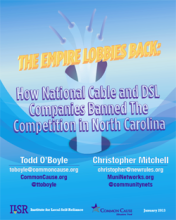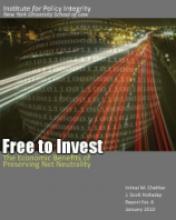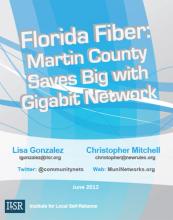
Fast, affordable Internet access for all.

Update: Read an updated version of this report, published in July 2021, here, titled Minnesota Broadband: Land of 10,000 Connectivity Solutions [pdf]. It revisits all of the below communities to see how they fared over the intervening years, while adding new counties, communities, and, for the first time, two local Internet Service Providers.
In our latest report, All Hands On Deck: Minnesota Local Government Models for Expanding Fiber Internet Access, we analyze how local governments in 12 Minnesota communities are expanding 21st century Internet access to their citizens.
In 2010, the Minnesota legislature set a goal for 2015 - universal access to high speed broadband throughout the state. Even though we have the technology to make that vision a reality, large swaths of the state will not meet that goal. Nevertheless, local folks who have chosen to take control of their connectivity are finding a way to exceed expectations, surpassing the choices in many metropolitan regions.
Some of the communities we cover include:
We delved into networks in Anoka, Carver, Cook, Lake, and Scott Counties. The report also shares developments in the municipalities of Chaska, Buffalo, and Monticello. We tell the story of RS Fiber, located in Sibley and part of Renville County. These communities provide examples of municipal networks, a variety of public private partnerships, and "dig once" policies.
The Government Accountability Office released a report today examining economic development and government-spurred broadband deployment. The report, titled Telecommunications: Federal Broadband Deployment Programs and Small Business looks at the effects of stimulus projects on opportunities for small business.
According to the press release:
“GAO’s investigation confirms the success of the Recovery Act’s broadband programs," said Rep. Waxman. “In rural and urban areas across the country, small businesses are benefitting from higher speeds and lower prices thanks to federal investment in this essential infrastructure. Expanding broadband access and quality is critical for American competiveness in the 21st century global economy. These were public dollars well spent.”
The report reviews communities around the country where either federal dollars have been invested in networks or local governments have made such investments. The results were consistent with our findings over the years - municipal networks create a business-friendly environment and contribute to economic development.
According to the report summary:
According to small businesses GAO met with, the speed and reliability of their broadband service improved after they began using federally funded or municipal networks.
Regarding competition, the GAO find that municipal networks spur competitor investments:
For example, following the construction of a fiber-to-the-home municipal network in Monticello, Minnesota, the two other broadband providers in the area made investments in their infrastructure to improve their broadband speeds. One of these providers stated that all of its networks undergo periodic upgrades to improve service, but upgrade schedules can change in order to stay competitive when there is a new service provider in a particular market.
The Open Technology Institute at the New America Foundation has released a report on data caps in the U.S. The report, Capping the Nation's Broadband Future, was authored by Hibah Hussain, Danielle Kehl, Benjamin Lennett, and Patrick Lucey.
The paper looks at the growing prevalence of monthly data caps by massive ISPs like Time Warner Cable, AT&T, and others. Authors conclude that data caps are effectively discouraging Internet usage with restrictions and limits that can be expensive. From the summary:
As this paper documents, data caps, especially on wireline networks, are hardly a necessity. Rather, they are motivated by a desire to further increase revenues from existing subscribers and protect legacy services such as cable television from competing Internet services. Although traffic on U.S. broadband networks is increasing at a steady rate, the costs to provide broadband service are also declining, including the cost of Internet connectivity or IP transit as well as equipment and other operational costs. The result is that broadband is an incredibly profitable business, particularly for cable ISPs. Tiered pricing and data caps have also become a cash cow for the two largest mobile providers, Verizon and AT&T, who already were making impressive margins on their mobile data service before abandoning unlimited plans.
The increasing prevalence of data caps both on the nation’s wireline and mobile networks underscore a critical need for policymakers to implement reforms to promote competition in the broadband marketplace. Data caps may offer an effective means for incumbents to generate more revenue from subscribers and satisfy investors, but making bandwidth an unnecessarily scarce commodity is bad for consumers and innovation. The future is not just about streaming movies or TV shows but also access to online education or telehealth services that are just starting to take off. Capping their future may mean capping the nation’s future as well.

In late 2006, Wilson, North Carolina, voted to build a Fiber-‐to-‐the-‐Home network. Wilson’s decision came after attempts to work with Time Warner Cable and EMBARQ (now CenturyLink) to improve local connectivity failed.
Wilson’s decision and resulting network was recently examined in a case study by Todd O’Boyle of Common Cause and ILSR's Christopher Mitchell titled Carolina’s Connected Community: Wilson Gives Greenlight to Fast Internet. This new report picks up with Wilson’s legacy: an intense multiyear lobbying campaign by Time Warner Cable, AT&T, CenturyLink, and others to bar communities from building their own networks. The report examines how millions of political dollars bought restrictions in the state that will propagate private monopolies rather than serve North Carolinians.
Download the new report here: The Empire Lobbies Back: How National Cable and DSL Companies Banned The Competition in North Carolina
These companies can and do try year after year to create barriers to community-‐owned networks. They only have to succeed once; because of their lobbying power, they have near limitless power to stop future bills that would restore local authority. Unfortunately, success means more obstacles and less economic development for residents and businesses in North Carolina and other places where broadband accessibility is tragically low.
It certainly makes sense for these big companies to want to limit local authority to build next-‐generation networks. What remains puzzling is why any state legislature would want to limit the ability of a community to build a network to improve educational outcomes, create new jobs, and give both residents and businesses more choices for an essential service. This decision should be made by those that have to feel the consequences—for better and for worse.
This story was originally posted on the ILSR website.

In 2010, the Institute for Policy Integrity at the New York University School of Law released a report titled Free to Invest: The Economic Benefits of Preserving Net Neutrality. The report, authored by Inimai Chettiar and J. Scott Holladay, is a great resource - substantial and very digestible - on what net neutrality really is, how it is (or is not) regulated, and the economic possibilities policy makers must consider when moving ahead.
The Institute looks at the economic relationships between content providers, ISPs, and consumers. In addition to the current economic structure, the report examines possible alternate pricing models that are contrary to our current net neutrality policies. We have extracted just a few excerpts and encourage you to get the full report.
There are five main findings that are examined in depth:
Internet Market Failure: The report explains how ISPs lose potential dollars under today's market structure. There is ample motivation for them to find a way to charge content providers based on delivery, and open up a whole new market far beyond our net neutrality policy.
The FCC’s nondiscrimination rule would prohibit an ISP from treating any content, application, or service in a “discriminatory” manner, subject to reasonable network management. This clearly bans pure price discrimination (charging different content providers different prices to access their subscribers). The regulation also bans ISPs from offering content providers a “take it or leave it” offer on access to their users. For example, an ISP like Verizon could not charge a website of a company like The New York Times a certain price for access to its subscribers by threatening to block the website from its network and therefore from its Internet subscribers.
Smart Policy Can Help: The authors of the report stress how the Internet must be viewed as a two pronged market - infrastructure to deliver the content and the content itself - and how both are equally important. Effective policy must recognize the delicacy of that balance.
Just this week, the Office of the Legislative Auditor General of the State of Utah released a report to the Utah Legislature on UTOPIA. The report, titled A Performance Audit of the Utah Telecommunications Open Infrastructure Agency rehashes prior criticisms of UTOPIA and tells the abridged story of the Auditor's understanding of UTOPIA's financial troubles.
While one can accept the report as truthful, it certainly is not comprehensive. Jesse Harris, of FreeUTOPIA notes that leaving out certain pieces of information taint the presumed impartiality of the report. From Jesse:
The Legislative Auditor General has published an audit of UTOPIA, and, as expected, it drags a fair amount of ancient history back into the spotlight. The report concludes that additional accountability will alleviate the problems that UTOPIA has experienced, but it missed the mark on a number of points.
The Audit Scope and Objectives are spelled out in the beginning as:
Members of the Utah Legislature asked for an audit of UTOPIA so residents of UTOPIA member cities might know how the organization has used its funds. Legislators also asked for a review the organization’s general management practices. To address their concerns, we developed an audit plan to review the following areas:
- The size and use of UTOPIA’s debt financing
- The causes leading to UTOPIA’s current financial condition
- UTOPIA’s management and board governance practices
While there are many bar graphs, pie charts, and dollar signs in the report and it seems to meet the scope and objectives, financial information alone does not explain UTOPIA's troubles. The first place to look is close to home.
The Open Technology Institute at the New America Foundation just released a report titled "The Cost of Connectivity." The report, authored by Hibah Hussain, Danielle Kehl, Benjamin Lennett, Chiehyu Li, and Patrick Lucey examines 22 cities across the planet for speed, triple play offerings, and what consumers can get for $35. The results, unfortunately, are not surprising. From the Report Summary:
The results indicate that U.S. consumers in major cities tend to pay higher prices for slower speeds compared to consumers abroad. For example, when comparing triple play packages in the 22 cities surveyed, consumers in Paris can purchase a 100 Mbps bundle of television, telephone, and high-speed Internet service for the equivalent of approximately $35 (adjusted for PPP). By contrast, in Lafayette, LA, the top American city, the cheapest available [triple play] package costs around $65 and includes just a 6 Mbps Internet connection. A comparison of Internet plans available for around $35 shows similar results. Residents of Hong Kong have access to Internet service with symmetrical download and upload speeds of 500 Mbps while residents of New York City and Washington, D.C. will pay the equivalent price for Internet service with maximum download speeds that are 20 times slower (up to 25 Mbps and upload speeds of up to 2 Mbps).
The results add weight to a growing body of evidence that suggests that the U.S. is lagging behind many of its international counterparts, most of whom have much higher levels of competition and, in turn, offer lower prices and faster Internet service. It suggests that policymakers need to re-evaluate our current policy approaches to increase competition and encourage more affordable high-speed Internet service in the U.S.
Forbes' Bruce Upbin reviewed the report and the implications and, once again, pointed out what we all know:

